|
< Earlier Kibitzing · PAGE 2 OF 11 ·
Later Kibitzing> |
May-01-13
 | | chancho: User: like
User: that |
|
May-01-13
 | | OhioChessFan: At the bottom of this page, there's a box that says "View another user profile". Just take a guess at a possible user name, type it in, hit enter, and see if there's a user with that name. For example, right now I'll try "Chevrolet".........and there's no such user. It is rather time consuming and takes some imagination, but I think it's the best underground part of Chessgames. PS: I just tried "Chevy" and there is in fact a user with that name. |
|
May-01-13
 | | OhioChessFan:
User: chanchoUser: lol |
|
| May-01-13 | | DcGentle: <PawnSac>: I can answer this question for you, and I can also give you a hint how to get more attention for your good analysis. In order to get a link for a word, you have to check whether this word is a registered user. That's easy, you see the form field "View another user profile:" close to the bottom of this page. There you can enter the word you need, for example: "Here"
If the user "Here" exists, the profile will come up and you can copy the link from the address field of your browser, like this (User: here). And you can get a link to your article by the Search Kibitzing page. This is reachable via the Premium Membership page or by the activation of a link bar via your preferences.
In the form field of the search kibitzing page you can enter for example puzzle user:pawnsac
and it will look for all your postings containing the word "puzzle". Then you look for the one posting that starts your article and to the left is a blue link "PawnSac chessforum". With the right mouse click you can select "copy link" and then you can insert it into your next posting that would be on the game page of your analyzed game, and readers can just click on this link and will find the start of your article in your forum. That's it.
Enjoy!
:-)
<DC> |
|
May-02-13
 | | PawnSac: < DcGentle: <PawnSac> By the way, your nick may suggest that you like a gambit now and then. > I've been known to toss a pawn or two <\__/> And by the way, i didn't respond to this comment earlier since i was working on the game commentary i posted the other day. I wasn't ignoring you. <My favorite way to play the Sicilian as White is the Morra Gambit> Yea i used to play it often in blitz. We called it the Morbid Gambit. < ..which has a doubtful reputation and will therefore never be seen on GM level. > GM's do not reject an opening simply because of "reputation". The reputation must be deserved. But i searched the position after 4.Nxc3 and 522 games came up. I had looked thru there before and found a number of GM games. < The reason is clear,> What i have heard GM's say is that they get the same kind of play and activity from normal Sicilian lines without having to sac the pawn. What i have personally seen is that I usually always get sufficient compensation to win back the gambited pawn, but then its a very level position. Even going thru Ken Smith's books (which i have) most of the positions in his analysis resolve to pretty level positions. < main theory prefers Bc4, and here this bishop can be easily attacked by a black pawn which means a loss of tempo for White > This is no different than with the Najdorf with a6 and b5 or the Sozin, or Fischer variation. They all revolve around play where the bishop comes under attack. and rightly so since it's a strong attacking piece against the black kingside. That bishop with the aid of a knight often target or sac at e6 or f7 < ..and then, why did they sac a pawn in the first place? > the missing C pawn does make a nice file for the Rac1, so the typical formation Bc4 Nc3 Nf3 Rc1 Rd1 Qe2 and Be3 or Bf4 is attractive, and against players of black below master level it does make for fun attacking chess. If we trace the origin of the ideas, in the romantic era there was the Scotch gambit, the Evens, the Danish, the Center and Alapin gambit and the whole family of Italian lines involving 1.e4 e5 with sacs on d4 c3 b2. SO, it was natural to investigate gambits of the same nature in Sicilian formations. And keep in mind Pal Benko was championing the "Benko" gambit, doing simuls around the country, so Ken Smith jumped on the band wagon doing the same with the Morra. Tho practice has shown that the Benko is more viable than the Morra. Be that as it may...
< Well, things are not as easy there, what if White can avoid a loss of the tempo? I tell you, they can, because Bc4 is not required, but current theory is silent there. So I developed my own. ( Took me several years, though, but I don't regret it. ) > Ok so you baited the hook. What's your main line? Do you play an early e5 and Bd3 instead of Bc4? Let's see your idea and maybe we can improve the line. |
|
| May-02-13 | | DcGentle: <<PawnSac>: < main theory prefers Bc4, and here this bishop can be easily attacked by a black pawn which means a loss of tempo for White > This is no different than with the Najdorf with a6 and b5 or the Sozin, or Fischer variation. They all revolve around play where the bishop comes under attack.> Well, yes, but don't forget, White has sacced a pawn already, and if White cannot keep up the pressure, compensation can easily fizzle and in the end White has just lost a pawn and a lost game. I'll show two problematic variants:
<Line A>:
<1. e4 c5 2. d4 cxd4 3. c3 dxc3 4. Nxc3 e6 5. Nf3 Nc6> I know that main theory wants to play <5. Bc4> but I am delaying a bishop move in order to see whether Black will develop their d-pawn first or not.
If Black plays <4. d6> (or first Nc6 and then d6) it's a rather different situation, because Black's DSB is confined. <Line B>:
(this one is considered as the refutation of the Morra by many people) <1. e4 c5 2. d4 cxd4 3. c3 dxc3 4. Nxc3 a6 5. Nf3 e6 6. Bf4 Nc6> If White now plays <7. Bc4>, Black can instantly seize the initiative playing <7... b5> with the better game. So why sac a pawn here? Makes no sense, doesn't it?
Well, in both cases I'll play Be2.
On the other hand, and here we arrive at <Line C>: <1. e4 c5 2. d4 cxd4 3. c3 dxc3 4. Nxc3 d6 5. Nf3 e6 6. Bc4> Here Black plays <4... d6> confining their DSB, and <6. Bc4> is just fine! Here there is a nice continuation that shows, what can happen if Black still believes they can harass Bc4: <6... Nf6 7. O-O Be7 8. Qe2 a6 9. Rd1 b5 10. e5 bxc4 11. exf6 gxf6 12. Nd2 d5 13. Nxc4> and White is fine.
But White will be fine in the other lines as well. |
|
May-02-13
 | | PawnSac: SMITH-MORRA Gambit ACCEPTED
GAMBIT ACCEPTED / START POSITION
1. e4 c5 2. d4 cxd4 3. c3 dxc3 4. Nxc3
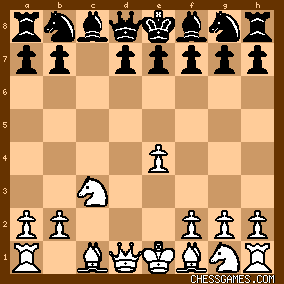
click for larger view MAIN VARIATION #1:
1. e4 c5 2. d4 cxd4 3. c3 dxc3 4. Nxc3 Nc6 5. Nf3 d6 6. Bc4 e6 7. O-O Nf6 8. Qe2 Be7 9. Rd1 e5 
click for larger view MAIN VARIATION #2:
1. e4 c5 2. d4 cxd4 3. c3 dxc3 4. Nxc3 Nc6 5. Nf3 d6 6. Bc4 e6 7. O-O Nf6 8. Qe2 a6 9. Rd1 Qc7 
click for larger view MAIN LINE (GM Matulovich / Ken Smith 1972):
1. e4 c5 2. d4 cxd4 3. c3 dxc3 4. Nxc3 Nc6 5. Nf3 d6 6. Bc4 e6 7. O-O Nf6 8. Qe2 Be7 9. Rd1 e5 10. Be3 O-O 11. Rac1 Be6 12. b4 Bxc4 13. Qxc4 Rc8 14. Qb3 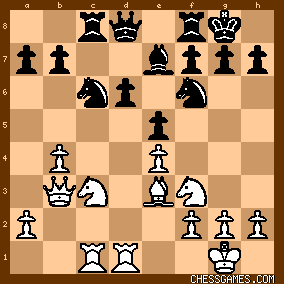
click for larger view |
|
| May-02-13 | | DcGentle: <PawnSac>: Yes, Why not, my theory is not changing much there, because <5... d6> played <before> <6... e6> is the for Black weaker method, the less problematic one for White. In the MAIN LINE (GM Matulovich / Ken Smith 1972), my main continuation goes like this: 12. Bd5 Ng4 13. Bc5 Bxd5 14. Rxd5 Nf6 15. Rdd1 Qd7 16. h3 a6 17. Qd3 h6 18. a3 Rac8 19. Be3 Rfe8 20. Nh4 Na5 21. Nf5 Nc4 22. Bxh6 Nxb2 23. Qg3 g6 24. Re1 Bf8 25. Qh4 Qe6 26. Bxf8 Rxf8 27. Re3 Nh5 28. Rb1 Nc4 29. Rd3 Rc5 30. Rxb7 
click for larger viewBut this is nothing engraved in stone, the line is several years old and there might be improvements. The interesting part is the one where Black FIRST plays ... e6, because they are not confining their DSB, and as indicated by my first posting, White might be able to lose the initiative rather quickly. My reason for White playing the Morra is: "Prevent Black from breathing starting with move 2." It's doable but proofed to be harder than I believed. |
|
May-02-13
 | | PawnSac: < DcGentle: I'll show two problematic variants:
<Line A>: < 1. e4 c5 2. d4 cxd4 3. c3 dxc3 4. Nxc3 e6 5. Nf3 Nc6> I know that main theory wants to play <5. Bc4> > If you mean 6.Bc4.. correct
< but I am delaying a bishop move in order to see whether Black will develop their d-pawn first or not. If Black plays <4. d6> (or first Nc6 and then d6) it's a rather different situation, because Black's DSB is confined. > We can look at the different situations.. but it is white to move…
6. ? you must play something. So to delay Bc4 you have to play a lesser move, or lose tempi. I assume you substitute Bc4 with 6.Be2 ? Here is the classic Morra structure for the white pieces: 
click for larger viewWith Be2 you block the queen’s best development square, and must find an alternate, as well as delay bringing the white rooks to the open files. Besides the fact i see no reason to delay 6.Bc4..
What alternate pattern do you give?
And what is wrong with this?:

click for larger view |
|
May-02-13
 | | PawnSac: Oh by the way Gc, i put a link in the Lenderman game, go check it out and see if i did it right and thanks for the explanation. |
|
| May-02-13 | | DcGentle: Yes, good posting on the game page and clicking on the link I was directed to the start of your analysis! Great!
:-) |
|
| May-02-13 | | DcGentle: You are right, from a positional viewpoint the bishop has a nice position on c4 and a rather passive one on e2. But I have a substitute for the bishop, that's the point, and there starts my new theory. Believe me, the decision to deposit the bishop on d2 was no easy one for me, but the line with <4... a6> is just too strong. Here Black's notoriously bad LSB becomes a boost to get to b7 and so into the game, additionally to the kick on the white bishop c4. No way, there must be a better way. And there is.
So guess what I might play in Line A of my first posting after <1. e4 c5 2. d4 cxd4 3. c3 dxc3 4. Nxc3 e6 5. Nf3 Nc6 6. Be2 d6 7. O-O Nf6> ? It's not that hard if you imagine that White after all has only one reasonable move here in order to continue development. 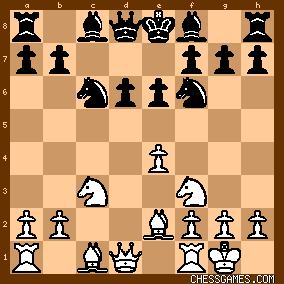
click for larger viewWhite to move. |
|
May-02-13
 | | PawnSac: < <Line B>:
(this one is considered as the refutation of the Morra by many people)
<1. e4 c5 2. d4 cxd4 3. c3 dxc3 4. Nxc3 a6 5. Nf3 e6 6. Bf4 Nc6>
If White now plays <7. Bc4>, Black can instantly seize the initiative playing <7... b5> with the better game. > If it is a refutation, only of Bf4, which is a mistake. 
click for larger viewblack can play 6. ..d6 and subsequently win a tempo with ..e5.
Can you guess the correct move?
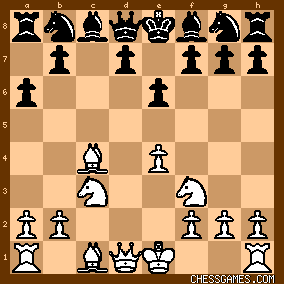
click for larger viewGligoric in his book said.. "The Paulsen or Kan Variation" set-up has not given black good results". If you are concerned about the bishop being attacked.. 6. ..b5 (this move, as when it is played in the main variations, leaves black too week on the queenside) and.. a) d6 8.0-0 Nf6 9.Qe2 Nbd7 10.Rd1 Bb7 11.a3 Be7 12.Bf4 Qb8 13.Rac1 0-0 14.Ba2 e5 15.Bg5 and white has the initiative. (Kinmark - Robatsch, Halle 1963) b) Bb7 8. Qe2 Bb4 9. O-O Bxc3 10. bxc3 Ne7 11. Ba3 Nbc6 12. Rfd1 Qa5 13. Qb2 Rd8 14. Nd4 and black is in trouble (Matulovic-Scocco, Ferrara, 1954). |
|
| May-02-13 | | DcGentle: *hmmm*
Well, believe me, I have tried a lot of lines.
The line with
1. e4 c5 2. d4 cxd4 3. c3 dxc3 4. Nxc3 a6 5. Nf3 e6 6. Bc4 b5 7. Bb3 Bb7 8. Qe2 can be improved by 8... d6. Black can play it soundly and slowly, he has won a pawn and is not forced to trade pieces, because bishop b3 bites on granite of the e6 - f7 pawn structure. He has also regained the tempo he lost by taking the gambit pawn. So he will be fine just developing without big risks. |
|
| May-02-13 | | DcGentle: Well, I'll close for today, and here there is the new move I want to play after <1. e4 c5 2. d4 cxd4 3. c3 dxc3 4. Nxc3 e6 5. Nf3 Nc6 6. Be2 d6 7. O-O Nf6>. It's <8. Qb3>.
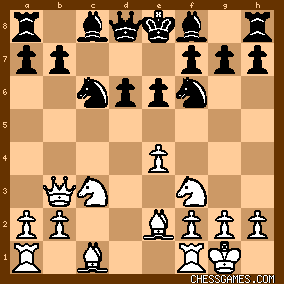
click for larger viewThe queen is taking over some of the tasks of the bishop that is missing on c4, but also looks at b7 already. |
|
| May-03-13 | | DcGentle: Well, already <6. Be2> turned out to be rather too much for a guy I played a correspondence game against 10 years ago, where Fritz was the dominating software ;-) I went over some of the variants with Houdini today and there were some glitches, but by and large the game is o.k., have a look: [Event "Morra gambit Test"]
[Site "rec.games.chess.analysis"]
[Date "2003.08.18"]
[Round "?"]
[White "Gentle, Dc"]
[Black "Schimerak"]
[Result "1-0"]
[ECO "B21"]
1. e4 c5 2. d4 cxd4 3. c3 dxc3 4. Nxc3 e6 5. Nf3 Nc6 6. Be2
Be7 7. O-O Nf6 8. e5 Ng4 9. Bf4 f6 10. exf6 Nxf6 11. Nb5 O-O
12. Bc7 Qe8 13. Bg3 Nd5 14. Bc4 Rf5 15. Re1 Qf8 16. Nbd4
Nxd4 17. Nxd4 Rg5 18. Nf3 Rh5 19. Rc1 Bc5 20. Ne5 Nf6 21.
Qf3 Bb6 22. Bb3 Kh8 23. Rcd1 Bc5 24. Bc2 Qe7 25. h3 a5 26.
Ng4 Ne8 27. Re5 Rxe5 28. Nxe5 Nf6 29. Bh4 d5 30. Ng4 Qf7 31.
Bg5 Be7 32. Rd4 Qh5 33. Qf4 e5 34. Nxe5 Be6 35. Bf5 Bg8 36.
Qh4 Bd8 37. Rg4 Qxh4 38. Rxh4 g6 39. Nxg6+ Kg7 40. Bh6+ Kf7
41. Ne5+ Ke8 42. Be3
1-0

click for larger viewBlack resigned.
The game was played in the public of the news group "rec.games.chess.analysis" and can be found there even today after about ten years. ;-) Even today I like the move <21. Qf3>, which threatens Bf4 followed by g4 trapping rook h5. This move still is not found by any existing engine, after 10 years, because it's positional. Of course Black should have played 7... d6, but White's bishop move didn't keep him alarmed, as it seems. |
|
May-03-13
 | | PawnSac: Cool, I'll check it out. I may not be able to get back on for a few days. My router went bad and lost wireless. But i've been looking over your Qb3 idea. I suspected that's where you'd put it. not much other choice actually. I see some things but not sure how serious they are. Have to think on it. cya soon |
|
| May-03-13 | | DcGentle: <PawnSac>: Well, there is more behind <8. Qb3> than I thought when I tried this move the first time in my analysis. It's unlikely that an engine will find the decisive line, though. BTW, in my preferences I have checked the boxes "Hide your chessforum from certain GMs" and
"Hide comments from Chessforum Activity"
This is recommended, when we talk about opening theory, that should not be read by a future WT opponent. Just for your info. |
|
| May-04-13 | | DcGentle: <PawnSac>: When you are back, you can find a core line of my Morra Gambit analysis here (DcGentle chessforum). I am curious about your reaction.
:-) |
|
| May-18-13 | | DcGentle: Well, anyways, <PawnSac>, we have all our lives beside chess, mine is minimal currently, because I need chess to create my chess engine, and any knowledge that can go in there is welcome. As you can read in my profile, the Morra formed me as an analyst, and in this opening true positional moves with a <wide range> are rare, so I was lucky that the recent world team game was different. Anyways, you gotta see the positional queen sac in the game linked to my forum. (Maybe you did already.) :-)
Later,
<DC> |
|
Jun-16-13
 | | PawnSac: Ok Dc,
It’s been quite a while since we started the discussion on the Morbid Gambit <G> as i have been extremely busy with other work. And i may still be hit and miss a bit with continued work related things plus a new website i'm building, but if I’m understanding you correctly, we're making a theoretical comparison between the two positions that arise as follows: 1. e4 c5 2. d4 cxd4 3. c3 dxc3 4. Nxc3 Nc6 5. Nf3 d6 6. Bc4 e6 7. O-O Nf6 8. Qe2 
click for larger view 1. e4 c5 2. d4 cxd4 3. c3 dxc3 4. Nxc3 Nc6 5. Nf3 d6 6. Be2 Nf6 7. O-O e6 8. Qb3 
click for larger view Is this correct?
And you also stated…
<The line with 1. e4 c5 2. d4 cxd4 3. c3 dxc3 4. Nxc3 a6 5. Nf3 e6 6. Bc4 b5 7. Bb3 Bb7 8. Qe2 can be improved by 8... d6. Black can play it soundly and slowly, he has won a pawn and is not forced to trade pieces, because bishop b3 bites on granite of the e6 - f7 pawn structure. He has also regained the tempo he lost by taking the gambit pawn. So he will be fine just developing without big risks. > so in your analysis, is this the critical problem-child line you are trying to improve or avoid for white? 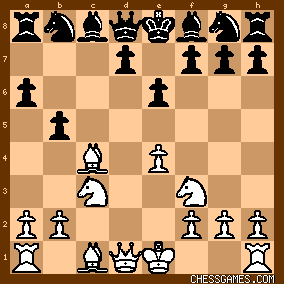
click for larger view that is.. Bc4 does not work for you because you feel ..b5 by black is too strong? Your whole motivation for the Bd2/Qb3 arrangement is primarily because of 6. ..b5 in the move order you gave in the above quote, correct? |
|
| Jun-16-13 | | DcGentle: Yes, the move order is decisive here. The Bd2/Qb3 could be seen as a general alternative to the usual set-up with Bc4/Qe2 scenario, <BUT> I believe according to my analysis, the Bd2/Qb3 alternative is only necessary if Black does <NOT> play pawn d6 as first move of the other relevant pawn moves, namely ... a6 or ... e6. By playing either of the latter first, he prevents his DSB from being cramped too early, and this causes the real problems for White in the Morra Gambit. So I am not saying "trash the whole theory", so I only say, "extend it sensibly where it's necessary". ;-) |
|
Jun-16-13
 | | PawnSac: In general, there are some obvious features that i think are most important when comparing the first 2 positions above (lets call them Be2/Qb3 vs. Qe2/Bc4 key positions).. COMPARISON:
(and this is off the top of my head, there's probably more, but...) The Q on b3 is more vulnerable to direct attack (with a move such as Na5, etc) than when on e2. The Qe2 directly supports the pawn advance e5, especially after Rd1 is played. This effect is strong enough that in many lines black must play a subsequent e6-e5 which yields to white the d5 square which can be immediately occupied. In the Qb3 variation this would not work so well since after Nd5 Nxd5 Qxd5 the Q is more vulnerable to a Be6 shot. The Qe2 offers more restraint against d6-d5 because of the pin on the E file, whereas the Be2 actually shields the black K against Re1+. In the Qe2 position, and especially after Rac1 and ..Qc7, white often has Nd5! sac possibilities because of counter pins and exposed king, whereas in the Qb3 formation much of that disappears. The Bc4 actually exerts more pressure on d5/e6 since, being a minor piece, there are additional sac possibilities, whereas with the Q on the same diagonal, this is far less likely. In the Qe2/Bc4 formation, after black plays ..a6 white has the option of playing a4 after which ..b5 can’t be played. In this instance the Qe2 formation is preferable. So i think all things considered, the Qe2/Bc4 formation is preferable. BUT, it seems the real focus is on the 3rd formation above..
(the early a6 without Nc6 patterns) I'll think on that for a bit. |
|
Jun-16-13
 | | PawnSac: btw, there's an interesting game with early a6 in the database.. Ankush Khandelwal vs William Bennet
British Championship (2006) · Sicilian Defense: Smith-Morra Gambit (B21) · 1-0 take a look. |
|
| Jun-16-13 | | DcGentle: Ok, looking at this game now, btw, if you copy and paste the URL of this game as it is into the posting text, it will come out like this: A Khandelwal vs W Bennet, 2006 |
|
 |
 |
|
< Earlier Kibitzing · PAGE 2 OF 11 ·
Later Kibitzing> |
|
|
|




![]()
![]()


